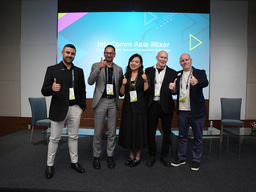AV Truth: BYOD

Welcome back to AV Truth, the weekly series where we talk about what really matters in AV. Last week, we stepped inside the rack room, the most ignored space with the most responsibility. This week, we face the one force stronger than any system design: the user’s own laptop.
Let’s be honest.
You can build the most beautiful, fully integrated system.
Room PC, Touch panel, Wireless sharing and DSP-tuned audio but then someone walks in, opens their laptop, and says:
“Can I just use this?”
And in that moment your system is either helpful… or in the way.
Why BYOD Is the New Normal
It’s not just convenience, it’s user behavior.
-
They know their device.
-
They trust how their apps behave.
-
They don’t have time to learn something new just to join a call.
Add to that: hybrid work policies, rotating office spaces, and tighter IT controls.
Suddenly, the personal laptop isn’t just preferred, it’s expected.
Where AV Still Falls Short
We’ve seen this story too many times:
-
The display works, but the mic and camera are stuck to the room PC.
-
There’s HDMI, but the user has USB-C.
-
Wireless sharing lags. Audio plays from the laptop instead of the ceiling speakers.
-
No clear switching and no clear instructions.
Result? The user connects from their phone while sitting in a $30K room.
What Real BYOD Support Looks Like
It’s not just adding a port or a sticker, it’s designing for trust:
-
USB passthrough that just works
-
Inputs users actually have (USB-C, HDMI, AirPlay…)
-
Seamless switching between room PC and laptop
-
Audio that follows the source, every time!
-
Clear signage so users don’t have to guess
Here’s the truth:
BYOD isn’t a feature, it’s a habit.
And if your system doesn’t support that habit?
It gets bypassed.
So the real question is simple:
“If I walked into this room with my laptop… would I trust it to work?”
If the answer is No, the system isn’t broken.
It’s just not designed for the user.
-
Xchange Advocates are recognized AV/IT industry thought leaders and influencers. We invite you to connect with them and follow their activity across the community as they offer valuable insights and expertise while advocating for and building awareness of the AV industry.






Please sign in or register for FREE
If you are a registered user on AVIXA Xchange, please sign in
A much-needed discussion, this is one AV solution that relies heavily on the end-user's meeting dynamics
Thank you! Absolutely agree as the success of any AV solution hinges on understanding how users actually work and interact.
A great reminder @Mohannad Mousa, CTS that successful AV design isn't just about integration! it's about trust and user behavior.
If the system doesn’t support BYOD seamlessly, it risks being bypassed entirely.
Simple, intuitive and flexible should be the new standard.
Thanks a lot! Trust and user behavior are at the heart of it all.
Let's debate! ;)
Beyond BYOD: The Rise of BYOID in Modern Collaboration Architectures
I’m in! 😄
I will go through it
Thank you!
Anyone else?
Well said! Manufacturers need to be transparent on what features are actually enabled, not 'coming real soon now.' Consultants and designers need dig deep to ensure client expectations are understood and reflected. Clients need to understand features often mean increased cost, and decide value v. investment does not mean you get something for nothing.
Absolutely agree, clients deserve to know and to understand what’s ready now, what still needs licenses, and what “future ready” really means
Thanks for the thoughtful comment!
There's another dynamic to this story too, the cloud platforms the user is accessing. Traditionally features like content sharing etc. have been solved with an AV solution, a video output of some sort, recaptured and encoded for the meeting or fed directly to the display. Now the platform vendors have provided another solution in software, one which doesn't require the user to know anything about ports and connectors. Provided the user can use the software client, they can drive the meeting room too. Although a great story, we have many years of user (low) expectations to overturn if we truly want meeting spaces to be transparent to the user.
Absolutely agree, the shift from hardware centric to software driven meeting experiences is both exciting and disruptive and we’re still facing the long standing challenge of low user expectations and inconsistent experiences.
Bridging that gap between what’s technically possible and what users expect is where the real impact lies.
Thanks for adding this important perspective!